
Macrophthalmus is a genus of crabs which are widespread across the Indo-Pacific. It contains the following species : Species in this genus are often referred to as sentinel crabs.

Diadema setosum is a species of long-spined sea urchin belonging to the family Diadematidae. It is a typical sea urchin, with extremely long, hollow spines that are mildly venomous. D. setosum differs from other Diadema with five, characteristic white dots that can be found on its body. The species can be found throughout the Indo-Pacific region, from Australia and Africa to Japan and the Red Sea. Despite being capable of causing painful stings when stepped upon, the urchin is only slightly venomous and does not pose a serious threat to humans.
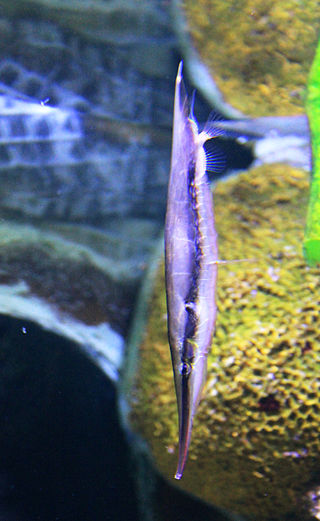
Aeoliscus strigatus, also known as the razorfish, jointed razorfish or coral shrimpfish, is a member of the family Centriscidae of the order Syngnathiformes. This unique fish adopts a head-down tail-up position as an adaptation for hiding among sea urchin spines. The razorfish is found in coastal waters in the Indo-West Pacific. Its natural habitat includes beds of sea grass and coral reefs, where sea urchins are found.

Metopaulias is a monotypic genus of fully terrestrial land crabs which do not need to go back to the sea to spawn. Metopaulias depressus is a reddish-brown crab about 2 centimetres (0.79 in) wide which lives in the pools of water that form in the leaves of bromeliads in Jamaica. The female lays about 90 eggs, then tends to her offspring, removing dead leaves that would deoxygenate the water and adding snail shells to the pool to provide high levels of calcium that they require, catching cockroaches and millipedes to feed them, and killing larvae of the damselfly Diceratobasis macrogaster which would otherwise eat them.
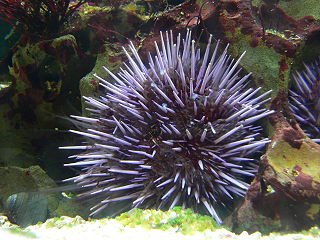
Strongylocentrotus is a genus of sea urchins in the family Strongylocentrotidae containing several species.

Echinoida is an order of sea urchins in the class Echinoidea. They are distinguished from other sea urchins by simultaneously possessing both an un-sculpted test and a feeding lantern with large plates fused across the top of each pyramid.

Percnon gibbesi is a species of crab. It is one of at least two species commonly called Sally Lightfoot, and is also referred to as the nimble spray crab or urchin crab. It has been described as "the most invasive decapod species to enter the Mediterranean".

Spinochrome D (2,3,5,6,8-pentahydroxy-1,4-naphthoquinone) is an organic compound with formula C
10H
6O
5, formally derived from 1,4-naphthoquinone through the replacement of five hydrogen atoms by hydroxyl (OH) groups.

Spinochrome B (2,3,5,7-tetrahydroxynaphthoquinone) is an organic compound with formula C
10H
6O
4, formally derived from 1,4-naphthoquinone through the replacement of four hydrogen atoms by hydroxyl (OH) groups.

Toxopneustes pileolus, commonly known as the flower urchin, is a widespread and commonly encountered species of sea urchin from the Indo-West Pacific. It is considered highly dangerous, as it is capable of delivering extremely painful and medically significant stings when touched. It inhabits coral reefs, seagrass beds, and rocky or sandy environments at depths of up to 90 m (295 ft). It feeds on algae, bryozoans, and organic detritus.

Echinoecus pentagonus, the sea urchin crab, is a species of crab in the family Pilumnidae found from the Red Sea and East Africa to French Polynesia and the Hawaiian Islands. This crab is a parasite that lives in the rectum of a sea urchin. In Hawaii, it chooses only Echinothrix calamaris, leaving few of these urchins unpopulated. Its curved and pointed carapace reaches only 0.5 inches (1.3 cm) in width.

The family Homolidae, known as carrier crabs or porter crabs, contains 14 genera of marine crabs. They mostly live on the continental slope and continental shelf, and are rarely encountered. Members of the Homolidae have their fifth pereiopods in a sub-dorsal position, which allows them to hold objects in place over the rear half of the carapace. The objects carried include sponges, black corals and gorgonians, and this behaviour may be a defence mechanism against predators. Some species have been observed carrying living sea urchins in a symbiotic relationship which allows them to benefit from the protection of the urchin's dangerous spikes.

The Camarodonta are an order of globular sea urchins in the class Echinoidea. The fossil record shows that camarodonts have been in existence since the Lower Cretaceous.
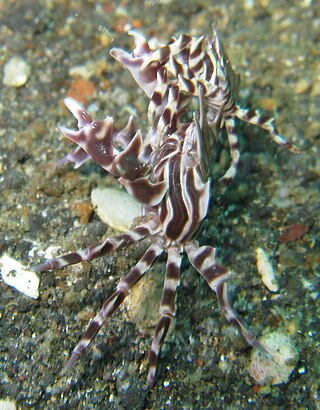
Zebrida is a small genus of distinctive striped crabs, known as zebra crabs, that live in association with sea urchins in the Indo-Pacific.

Zebrida adamsii is a distinctively striped species of crab that lives in association with a sea urchin in the Indo-Pacific region. It is cryptically coloured with vertical stripes and has special adaptations to its legs to enable it to cling to its host's spines.
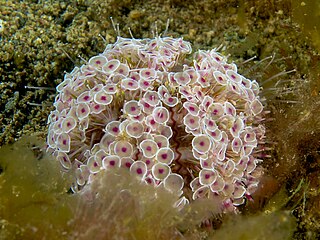
Toxopneustes is a genus of sea urchins from the tropical Indo-Pacific. It contains four species. They are known to possess medically significant venom to humans on their pedicellariae. They are sometimes collectively known as flower urchins, after the most widespread and most commonly encountered species in the genus, the flower urchin.
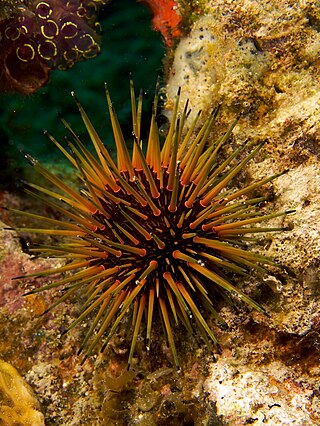
Echinometra viridis, the reef urchin, is a species of sea urchin in the family Echinometridae. It is found on reefs in very shallow parts of the western Atlantic Ocean and the Caribbean Sea.

Dorippe frascone, the urchin crab or carrier crab, is a small species of crab in the family Dorippidae that was first described scientifically by J.F.W. Herbst, in 1785. It is found in the Red Sea and parts of the western and eastern Indian Ocean. It often has a symbiotic relationship with a long-spined sea urchin and carries one around on its carapace.

Diadema paucispinum, the long-spined sea urchin, is a species of sea urchin in the family Diadematidae. It is found in the western Indo-Pacific Ocean and in Hawaii and other east Pacific islands.

Pseudocentrotus depressus, commonly known as the pink sea urchin, is a species of sea urchin, one of only two species in the genus Pseudocentrotus. It was first described in 1864 by the American marine zoologist Alexander Agassiz as Toxocidaris depressus, having been collected during the North Pacific Exploring and Surveying Expedition undertaken by Captain Cadwalader Ringgold and later Captain John Rodgers.



















